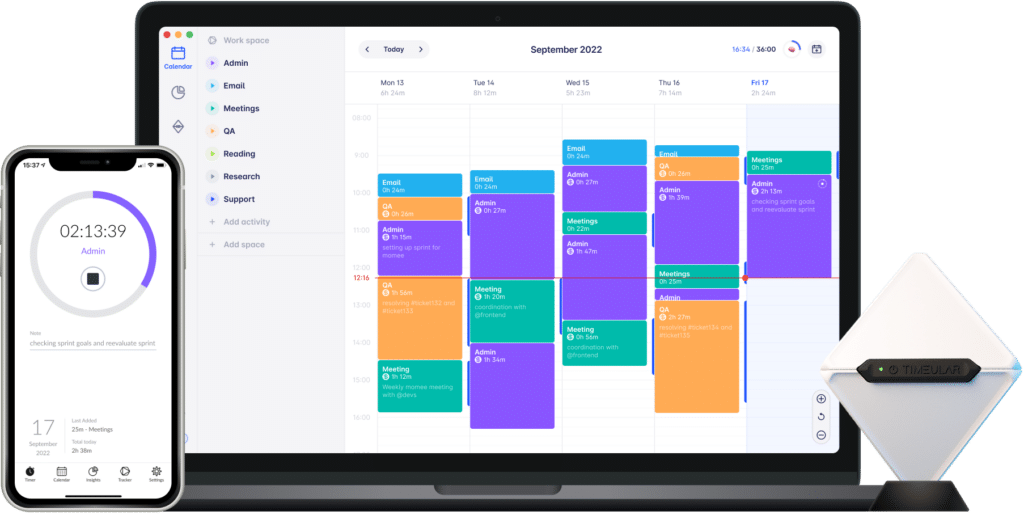Come calcolare le ore di retribuzione: Metodi e strumenti
Precision in payroll calculation isn’t just a business necessity; it’s the heartbeat of fair compensation and smooth operations. Beyond meeting legal requirements, nailing payroll management is a key player in boosting employee satisfaction, fostering trust, and keeping the financial house in order.
This article is your go-to guide for tracking hours worked, crunching the numbers for total hours, and making the whole process a breeze with nifty tool like a time-tracking app.
Dive into our step-by-step guide to discover how to calculate payroll hours.
Track all work-related time matters in a single place: working hours, overtime and leave.
What are payroll hours?
Payroll hours are a critical part of the payroll process and refer to the total amount of time that an employee has worked during a specific pay period.
This time is typically measured with a payroll tracker in hours and minutes, and it may include overtime calculations and paid time off, such as vacation or sick leave. Payroll hours are usually used to calculate gross pay, calculate overtime hours, and comply with labor laws.
- Scoprire: Tracciamento del tempo aziendale da parte di Timeular
The importance of tracking employee hours
Tracking employee hours is a crucial practice for businesses of all sizes. A tool like team time tracker by Timeular serves several important purposes, including:
- Accurate payroll management: Employee time tracking ensures accurate payroll calculations, ensuring employees receive their wages correctly, including overtime pay, bonuses, and other compensation.
- Enforcing labor laws: Time tracking helps organizations comply with labor laws, such as the Fair Labor Standards Act (FLSA) and local wage and hour regulations. By maintaining accurate records, employers can avoid costly fines or legal challenges related to unpaid overtime, minimum wage violations, or improper recordkeeping.
- Project management and resource allocation: Tracking employee hours provides valuable insights into how time is being spent on projects. This information helps managers identify potential inefficiencies, optimize workflows, and allocate resources more effectively.
- Time reporting, cost control, and budgeting: Time tracking data helps businesses track project costs and identify areas where expenses can be reduced, which is essential for financial planning and project budgeting.
- Absence management and attendance tracking: Tracking employee leave absences (sick leave, vacation, personal days) provides insights into workforce patterns and helps HR departments manage absences effectively (Read: Best Attendance Tracker Apps).
- Performance evaluation and recognition: Time-tracking data can be used to evaluate employee performance and identify areas for improvement. This information can also be used to recognize and reward high-performing employees.
- Data-driven decisions: Time-tracking data can be used to identify trends, patterns, and areas for improvement in various aspects of the business, from productivity and project management to employee engagement, which helps businesses make informed decisions that enhance overall performance.
- Compliance with project contracts: When working on projects for clients, time tracking ensures adherence to project contract timelines and budgets. This helps maintain client satisfaction and avoid potential disputes.
- Tracking overtime: An overtime tracker provided within time tracking apps helps identify instances of overtime, ensuring fair compensation and compliance with labor laws.
For one-time payroll hours calculations use our free Time Card Calculator.
- Scoprire: Tracciamento del tempo aziendale da parte di Timeular
Common challenges in calculating payroll hours
Calculating payroll hours accurately can be a complex task, especially for businesses with a large or diverse workforce. Several challenges can arise during the payroll calculation process, potentially leading to inaccuracies, errors, and compliance issues, such as:
Manual data entry and errors
There are several challenges when your employees manually calculate hours worked. Manually entering hours worked or using spreadsheets to calculate overtime hours can introduce a high risk of errors.
Human error in transcribing all the hours, manually calculating hours worked, or applying deductions in decimal format can lead to inaccurate payroll checks, miscalculations of overtime pay, and missed deductions.
Dealing with fluctuating pay rates and schedules
Employers handling employees with diverse hourly wage, shift schedules, or overtime threshold encounter the challenge of precisely computing hours for payroll.
Employees with non-standard work schedules, such as split shifts, irregular hours, or compressed workweeks, require careful attention to calculate their pay accurately.
- Read also: How to schedule employees effectively
Juggling multiple pay rates, calculating average hours, and factoring in unpaid breaks for hourly workers can be a time-consuming process within the payroll system.
Moreover, manually calculating hours worked adds a layer of complexity, increasing the likelihood of errors. For this reason, employees favor payroll solutions like automatic time clock app.
Tracking time off and paid leaves
Accurate tracking of time off, vacation, sick leave, and other paid leaves is crucial to calculate total work hours correctly.
Manually managing time off records can lead to data entry errors, missing records, and inaccurate payroll calculations.
For this reason, an all-in-one online solution for tracking working hours and time off in one place is recommended.
TIP: Read our blog to discover the top employee leave management system.
How to calculate payroll hours
There are three primary methods for calculating payroll hours: manual calculation, using online time clock apps that integrate with payroll solutions, or directly through payroll solutions.
What is important to note is that before calculating payroll hours, you need an accurate system to track your employees’ worked hours.
To ensure employees buy-in and timesheet accuracy, you need an effortless and smart time tracking app supercharged with automation. Additionally, keep in mind that employees will only track time honestly if they don’t feel monitored in real time.
Manual calculation
This method involves manually recording employee timesheets, calculating overtime, and applying deductions. It’s usually performed in Excel or Google Docs.
It represents the most fundamental time tracking method, also being the most time-consuming, error-prone, and lacking automation. Consequently, it is less suitable for businesses with a large or diverse workforce.
Risorse:
- Time-tracking spreadsheet templates
- Time allocation templates
- Modelli gratuiti di timesheet per le ore fatturabili
User-friendly time clock software

A time clock app like Timeular automates the process of recording and calculating employee hours, reducing the risk of errors and making payroll processing more efficient.
Timeular provides several different, user-friendly time tracking methods, including automatic time tracking, a physical time tracker, or tracking time with keyboard shortcuts. Each method reduces daily time tracking to under 1 minute!
What’s more, unlike many other time clock apps, Timeular is fully compliant with GDPR regulations, ensuring that user data is protected and privacy rights are respected.
Additionally, it has a 24h delay for time entries to appear on the managers side, which prevents micromanagement.
Time clocks typically integrate with your payroll tool to automate payroll generation, and Timeular does, too. Check the integrations page.
Payroll software
Payroll tools usually provide several in-built features, including time tracking, deduction management, and payroll calculation. It eliminates the need for manual calculations and reduces the risk of errors.
However, as payroll software is usually created for payroll experts and not for employees who are tracking time daily, it tends to overcomplicate the time tracking process. This, in turn, results in inaccurate timesheets which leads to delayed or incorrect payments.
Hence, we highly recommend choosing user-friendly time clock software that your employees will genuinely enjoy using, and seamlessly integrating it with the payroll app.

How to manually calculate payroll hours
1. Collect timesheets or timekeeping records
Request your employees to record their clock in and clock out time dilligently.
Gather timesheets from all employees, ensuring they are accurate and complete. Check for any missing or incomplete timesheets and request them from employees promptly.
Ensure timesheets are submitted within the designated time frame to avoid delays in payroll processing. If the employee noted 4 hours and 13 minutes, use the exact number for their payroll.
2. Review and verify employee hours
Scrutinize timesheets for any inconsistencies or discrepancies. Verify that the recorded hours align with the employee’s regular work schedule and any approved absences or overhours.
Investigate any unusual or excessive hours to ensure accuracy and compliance with labor laws.
3. Calculate hours worked
Determine the employee’s regular workweek based on their employment contract or company policy.
Multiply the regular workweek by the standard work hours per day, typically 8 hours. Subtract unpaid breaks or meal periods when calculating regular hours.
Resource: Employee work schedule template
4. Handling overtime hours
Identify total hours worked beyond the regular workweek (i.e. 40 hours per week) or more than the standard work hours per day.
Calculate overtime pay by multiplying the overtime hours by the overtime pay rate, typically 1.5 times the regular pay rate. Ensure overtime hours are compliant with labor laws and applicable exemptions.
Read also: Overtime calculation formula
5. Accounting for breaks and meal periods
Exclude unpaid breaks and meal periods from regular and overtime hours calculations.
Clearly define the duration and frequency of breaks and meal periods in company policies or employee handbooks. Documented approved breaks and meal periods on timesheets to maintain transparency and accuracy.
6. Calculating total payroll hours
Add regular hours to overtime hours to determine the total payroll hours for each employee.
Ensure the total payroll hours accurately reflect the employee’s work for the pay period.
7. How to convert minutes for payroll
Round minutes to the nearest quarter hour or tenth of an hour, following company policy or payroll software settings to maintain consistency and avoid discrepancies in payroll calculations.
Additionally, ensure to convert time to decimal form when calculating the gross wage, using the sum function based on the total number of hours worked.

Best practices for manual payroll hours calculation
While manual calculations can be time-consuming and prone to errors, following best practices can help ensure accuracy and efficiency. Some key steps to consider:
1. Ensuring timesheet accuracy
Timesheets function as the foundation for payroll calculations. Thoroughly reviewing and verifying timesheets is crucial to ensure that the recorded hours reflect the actual time of work performed by each employee.
This involves checking for inconsistencies, missing data, and discrepancies between timesheets and other records.
Read also: What are manual timesheets?
2. Understanding wage and hour laws
Accurate payroll calculations must comply with applicable labor laws, including the FLSA. Understanding these laws is essential to ensure that employees are paid correctly for their hours worked, including overtime, minimum wage, and break requirements.
3. Verifying employee classifications
Employee classifications determine their pay rates, overtime eligibility, and other compensation factors.
It’s crucial to accurately classify employees based on their job duties, responsibilities, and tenure, especially because misclassification can lead to legal issues and financial penalties.
4. Double-checking calculations for accuracy
Manual calculations are prone to human error, so it’s essential to double-check and verify the accuracy of all payroll calculations. This includes reviewing overtime calculations, deductions, and total pay amounts to reduce the risk of errors.
Strumenti consigliati:

Streamlining payroll hours calculation with software
Since manual payroll hours calculation can be extremely time-consuming and not appropriate for bigger companies, payroll software has become a very useful and valuable tool to optimize and ensure accurate calculation.
Benefits of payroll software
1. Automation and time-saving features
Payroll software can automate many of the manual tasks involved in payroll processing, such as timesheet entry, payroll calculations, deduction calculations, and paycheck generation.
This automation can save businesses a significant amount of time and effort, freeing up staff to focus on more strategic and value-added activities.
Read also: What are the benefits of workplace automation?
2. Accuracy and error reduction
Manual payroll processes are prone to errors, which can lead to inaccurate paychecks, missed deductions, and compliance issues.
Payroll software eliminates the risk of human error by automating calculations and using built-in checks and balances.
3. Compliance with labor laws
Payroll software helps businesses stay compliant with complex labor laws, including minimum wage requirements, overtime pay rules, and tax regulations.
The software automatically calculates and applies deductions based on employee data and pay rules, ensuring businesses adhere to all applicable regulations.
4. Reporting and analytics capabilities
Payroll software provides valuable reporting and analytics capabilities that can help businesses gain insights into their payroll data.
This information can be used to identify trends, track expenses, and make informed decisions about compensation and payroll practices.
TIP: Discover the best software to automate repetitive tasks

Choosing the right payroll software
Navigating the range of available payroll software options can be daunting, but selecting the right solution is crucial for streamlining payroll processes, optimizing efficiency, and ensuring compliance with labor laws.
1. Features to consider
When evaluating payroll software, carefully consider the following key features to ensure it aligns with your specific needs:
- Ease of use – it’s key!
- Automated calculations
- Integration with HR systems
- Compliance with labor laws and requirements
- Reporting e analisi
- Security and data protection
2. Popular payroll software options
- Timeular: It’s a time clock software that puts simplicity first. In an effortless, smart and secure way it lets you and your team track all work-related time matters in one place (working hours, overtime and leave). It provides multiple effortless time tracking methods that cater to the needs of different users, making time capturing fast and enjoyable.
- ADP Workforce Now: ADP Workforce Now is a comprehensive Human Capital Management (HCM) platform that provides a wide range of features for managing payroll, benefits, HR administration, and workforce management. It is designed for businesses of all sizes, from small organizations to large enterprises.
- Rippling: Rippling is a comprehensive payroll, benefits, and HR platform that simplifies and automates various aspects of employee management. It offers a wide range of features, including automation, multiple integrations, and a wide range of benefits administration capabilities.
- Gusto: Gusto is a payroll and people management platform that helps businesses streamline their payroll processes, manage HR tasks, and stay compliant with labor laws. Its main features include multiple integrations, paycheck generation and delivery, employee onboarding and offboarding, and more.
3. Implementation and training
Selecting the right payroll solution is not the end of the line; instead, it is the first step to successful implementation. Here are some key considerations:
Choose a reputable vendor: Partner with a reputable vendor that offers comprehensive onboarding, training, and support services.
Conduct a thorough needs assessment: Clearly define your payroll needs and requirements before selecting software and implementing it.
Provide training to employees: Offer comprehensive training to payroll administrators and employees involved in the payroll process.
Establish clear roles and responsibilities: Define clear roles and responsibilities for payroll processes to ensure accountability and efficiency.
Monitor and evaluate performance: Regularly monitor the performance of the new payroll software and identify areas for improvement.
- Related content: Read “AI in business examples” and find out how AI helps HR.
Conclusione
As we’ve seen through this guide, calculating payroll hours is a very important and sensitive task in an organization and requires attention and proper tools for accurately tracking employee worked hours.
By following this guide, you will ensure more accurate payroll hour calculations and an easier and more automated process.
FAQ
1. How do I calculate payroll hours for hourly employees?
Calculating payroll hours for hourly employees involves several steps, including collecting timesheets or timekeeping records, reviewing and verifying employee hours, calculating regular and overtime hours, accounting for breaks and meal periods, and calculating total payroll hours.
2. What is the best way to track employee hours?
The best way to track employee hours is by using accurate time-tracking software that can help you automate the process of recording employee hours, such as Timeular.
3. How do I handle overtime calculations in payroll?
To handle overtime calculations in payroll, identify and track hours worked beyond the regular workweek, calculate overtime pay, reconcile with labor laws, exclude meal and break periods, handle exempt and nonexempt employees, automate calculations, review and verify, maintain records, and seek guidance when needed.
4. Are breaks and meal periods included in payroll hours?
No, breaks and meal periods are not included in payroll hours. Breaks are typically unpaid and are intended to allow employees to rest and recuperate from their work.
5. Can I use Excel for payroll hours calculation?
Yes, you can use Excel for payroll hours calculation, but it may not be the best option for larger businesses or those with complex needs. Payroll software is usually more efficient and user-friendly, and it can handle the complexities of payroll calculations for large or regulated businesses.
6. What are the consequences of inaccurate payroll calculations?
Inaccurate payroll calculations can lead to legal trouble, financial penalties, lost wages, reduced productivity, and damaged relationships for both employers and employees. To avoid these consequences, employers should use payroll software, train employees, review payroll records regularly, and conduct audits.
7. How often should payroll hours be calculated?
Payroll hours should be calculated as soon as possible after the pay period ends. This will help to ensure that employees are paid on time and that there are no errors in the payroll calculations.
8. What are the legal requirements for payroll hour tracking?
The legal requirements for payroll hour tracking vary from country to country. The FLSA, for example, requires employers to keep accurate records of employee hours worked and to pay overtime to non-exempt employees who work more than 40 hours in a workweek.
9. How can payroll software simplify the payroll process?
Payroll software can simplify the payroll process by automating many of the tasks involved, such as calculating wages, deductions, and taxes, which can save time and reduce the risk of errors. Additionally, payroll software can help to ensure compliance with labor laws and regulations.
Potresti essere interessato a:

